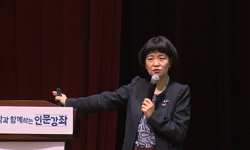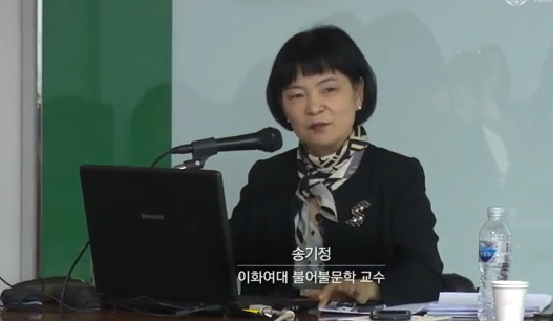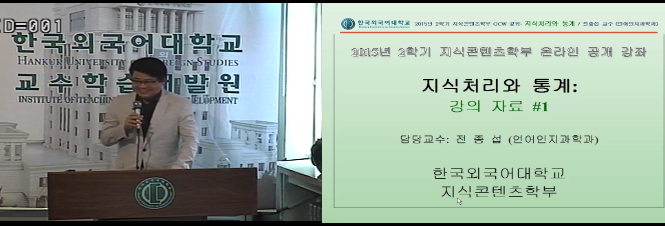This study examined that Kim Nam-cheon’s series of Aquarium of Love were closely related to the process of expanding and zoning Kyongsong(Great Keijo) plan. Until now, the importance of Kyongsong in Kim Nam-cheon has not received much attention. The...
http://chineseinput.net/에서 pinyin(병음)방식으로 중국어를 변환할 수 있습니다.
변환된 중국어를 복사하여 사용하시면 됩니다.
- 中文 을 입력하시려면 zhongwen을 입력하시고 space를누르시면됩니다.
- 北京 을 입력하시려면 beijing을 입력하시고 space를 누르시면 됩니다.

김남천의 『사랑의 수족관』 연작과 비총체화된 총체성 = Kim Nam-cheon’s series of Aquarium of Love and the Detotalized Totality
한글로보기부가정보
다국어 초록 (Multilingual Abstract)
This study examined that Kim Nam-cheon’s series of Aquarium of Love were closely related to the process of expanding and zoning Kyongsong(Great Keijo) plan. Until now, the importance of Kyongsong in Kim Nam-cheon has not received much attention. The literary theory of observation, which can be said to be the completion of Kim Nam-cheon's creative methodology, is based on the study of Balzac whose literature presupposes a close correlation between literature and the environment. Just as Balzac repeated various methodological searches to recreate the overall pattern of Paris, the capital of France in 19th century, Kim tried to closely observe the changes in spatial order and characteristics of detailed zones after the expanded Kyongsong and embodied them literary. The series of Aquariums of Love can be said to be the result of such efforts. Among modern Korean novelists, Kim can be evaluated as the author who most precisely embodies the historical changes of expanded Kyongsong as a novel.
In the Aquarium of Love series, there are places such as hubs that attract various characters and connect works. These are located in the east, west, north, and south of Kyongsong, respectively, which can be said to be a change that occurred when the dual urban structure of Kyongsong. Wondong is a place name derived from the sponsorship of Changdeok Palace and symbolizes the space of emerging bourgeois, which took over new wealth and power on behalf of kings and aristocrats of the Joseon Dynasty. Meijimachi is the center of financial capital and can be said to be a place where young people gather dreaming of a quick change. The Jukcheomjeong is a place where the latest residential areas have been built in earnest after the expansion of Kyongsong. The area of Dongsungdong, where Kyongsong University is located, is described as a space where young intellectuals of colonial Joseon want to grow, but eventually get killed or expelled.
The expansion of Kyongsong meant the transition from a nation-centered political city to a capital-centered industrial city. As the area expanded, Kyongsong was developed by dividing it into residential, commercial, industrial, and scenic areas, and each area was required to have a network with each other. And residential areas were divided according to the economic class. Each district of the city has a conciliatory relationship with the formation of a network of various characters in the feature novel in that they are closely related to each other while taking charge of a part of the entire city. Kim Nam-cheon’s works attempted to read the characteristics and relationship patterns of each district through various characters placed in the urban space of Kyongsong.
참고문헌 (Reference)
1 가와무라 미나토, "한양 경성 서울을 걷다" 다인아트 2004
2 전남일, "한국 주거의 공간사" 돌베개 2010
3 미셸 레몽, "프랑스 현대소설사" 현대문학 2007
4 차승기, "폐허로부터의 비전 - 일제말기 김남천의 소설론과 탈식민의 계기" 민족문학사연구소 (61) : 131-158, 2016
5 데이비드 하비, "파리 모더니티" 생각의나무 2010
6 김백영, "지배와 공간(식민지도시 경성과 제국 일본)" 문학과지성사 2009
7 이동재, "전환기(轉換期), 검약의 공간적 상상력 - 김남천 「경영」의 공간적 표상을 중심으로" 사단법인 한국문학과예술연구소 (40) : 259-290, 2021
8 앤드루 고든, "재봉틀과 일본의 근대" 소명출판 2021
9 정하늬, "일제 말기 소설에 나타난 '청년' 표상 연구" 서울대학교 대학원 2014
10 윤대석, "일본이라는 거울: 이광수가 본 일본·일본인" 서울대학교 일본연구소 3 : 2010
1 가와무라 미나토, "한양 경성 서울을 걷다" 다인아트 2004
2 전남일, "한국 주거의 공간사" 돌베개 2010
3 미셸 레몽, "프랑스 현대소설사" 현대문학 2007
4 차승기, "폐허로부터의 비전 - 일제말기 김남천의 소설론과 탈식민의 계기" 민족문학사연구소 (61) : 131-158, 2016
5 데이비드 하비, "파리 모더니티" 생각의나무 2010
6 김백영, "지배와 공간(식민지도시 경성과 제국 일본)" 문학과지성사 2009
7 이동재, "전환기(轉換期), 검약의 공간적 상상력 - 김남천 「경영」의 공간적 표상을 중심으로" 사단법인 한국문학과예술연구소 (40) : 259-290, 2021
8 앤드루 고든, "재봉틀과 일본의 근대" 소명출판 2021
9 정하늬, "일제 말기 소설에 나타난 '청년' 표상 연구" 서울대학교 대학원 2014
10 윤대석, "일본이라는 거울: 이광수가 본 일본·일본인" 서울대학교 일본연구소 3 : 2010
11 강인숙, "일본 모더니즘 소설 연구" 생각의나무 2006
12 송기정, "오노레 드 발자크-세기의 창조자" 페이퍼로드 2021
13 게오르크 루카치, "역사소설론" 거름 1987
14 김백영, "식민지 도시계획을 둘러싼 식민 권력의 균열과 갈등: 1920년대 ‘대경성(大京城)계획’을 중심으로" 한국사회사학회 (67) : 84-128, 2005
15 장문석, "소설의 알바이트화, 장편소설이라는 (미완의) 기투 : 1940년을 전후한 시기의 김남천과 『인문평론』이라는 아카데미, 그 실천의 임계" 민족문학사연구소 (46) : 216-257, 2011
16 프랑코 모레티, "세상의 이치" 문학동네 2005
17 김남천, "세기의 화문" 1938
18 유슬기, "서울 도성 안 동북부 지역의 신흥부촌 형성 과정" 서울대학교 대학원 2017
19 전진성, "상상의 아테네, 베를린 도쿄 서울" 천년의상상 2015
20 김남천, "사랑의 수족관"
21 김남천, "바다로 간다"
22 피터 브룩스, "멜로드라마적 상상력" 소명출판 2013
23 김남천, "낭비" 1940
24 김남천, "김남천전집1" 박이정 2000
25 장두영, "김남천의『사랑의 수족관』론 ― 1930년대 후반 식민지 자본주의 대응 양상을 중심으로" 한국현대문학회 (23) : 323-363, 2007
26 와다 도모미, "김남천의 취재원 (取材源) 에 관한 일고찰" 서울대학교 국어국문학과 23 : 1998
27 홍덕구, "김남천의 <사랑의 수족관> 다시 읽기 - 장소와 공간의 문제를 중심으로" 구보학회 (13) : 41-74, 2015
28 서경석, "김남천의 <발자크 연구노트>론" 대구대학교 인문과학연구소 19 : 1999
29 임희현, "김남천 연작소설 연구" 서울대학교 2015
30 황지영, "김남천 소설에 나타난 ‘여성 경제적 인간’ 연구" 구보학회 (15) : 212-238, 2016
31 김남천, "구름이 말하기를" 1942
32 이경아, "경성의 주택지" 집 2019
33 박철수, "경성의 아파트" 집 2021
34 서울역사박물관, "경성 상점가(대경성부대관과 대경성도시대관으로 보는)" 서울역사박물관 2018
35 황두진, "가장 도시적인 삶" 반비 2017
36 박광현, "‘재조선(在朝鮮)’ 일본인 지식 사회 연구" 일본연구소 19 : 119-144, 2006
37 김철, "‘근대의 초극’, ‘낭비’ 그리고 베네치아-김남천과 근대초극론" 민족문학사연구소 18 : 2001
38 김남천, "T일보사" 1939
39 Moretti, Franco, "The Bourgeois" Verso 2013
40 Brooks, Peter, "Realist Vision" Yale University Press 2008
41 Jameson, Fredric, "Marxism and Form" Princeton University Press 1974
42 Conroy, Melanie, "Literary Geographies in Balzac and Proust" Cambridge University Press 2021
43 Moretti, Franco, "Atlas of the European Novel 1800-1900" Verso 1998
동일학술지(권/호) 다른 논문
-
이효석의 「마작철학」과 문화 현상으로서 ‘정어리 열풍’
- 한국현대문학회
- 전봉관
- 2022
- KCI등재
-
소설로 보는 김정은 시대 ‘인민생활향상’의 의미 - 리희찬의 『단풍은 락엽이 아니다』를 중심으로
- 한국현대문학회
- 이예찬
- 2022
- KCI등재
-
일본을 거쳐 번역된 세계 : 이케베 요시카타의 『世界讀本』과 김하정의 『世界一覽』 비교 고찰
- 한국현대문학회
- 조윤정
- 2022
- KCI등재
-
‘이데올로기’를 넘어선 ‘사상’과 ‘문학’의 가능성 모색 - 이병주의 관-경계적 서사를 중심으로
- 한국현대문학회
- 김민수
- 2022
- KCI등재
분석정보
인용정보 인용지수 설명보기
학술지 이력
| 연월일 | 이력구분 | 이력상세 | 등재구분 |
|---|---|---|---|
| 2026 | 평가예정 | 재인증평가 신청대상 (재인증) | |
| 2020-01-01 | 평가 | 등재학술지 유지 (재인증) |  |
| 2017-01-01 | 평가 | 등재학술지 유지 (계속평가) |  |
| 2013-01-01 | 평가 | 등재학술지 유지 (등재유지) |  |
| 2010-01-01 | 평가 | 등재학술지 유지 (등재유지) |  |
| 2008-10-10 | 학술지명변경 | 외국어명 : The Journal of Korean Modern Literature -> The Journal of Modern Korean Literature |  |
| 2007-01-01 | 평가 | 등재학술지 선정 (등재후보2차) |  |
| 2006-01-01 | 평가 | 등재후보 1차 PASS (등재후보1차) |  |
| 2004-01-01 | 평가 | 등재후보학술지 선정 (신규평가) |  |
학술지 인용정보
| 기준연도 | WOS-KCI 통합IF(2년) | KCIF(2년) | KCIF(3년) |
|---|---|---|---|
| 2016 | 0.72 | 0.72 | 0.75 |
| KCIF(4년) | KCIF(5년) | 중심성지수(3년) | 즉시성지수 |
| 0.84 | 0.91 | 1.388 | 0.16 |




 DBpia
DBpia





